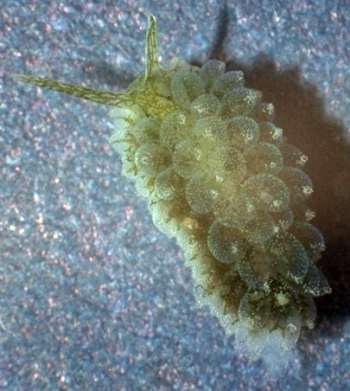
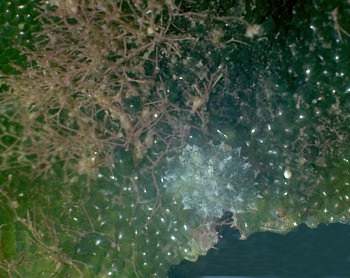
Ercolania coerulea
Trinchese, 1892
Order: SACOGLOSSA
Superfamily: LIMAPONTIOIDEA
Family: Limapontiidae
DISTRIBUTION
Originally described from the Mediterranean, it has also been reported from the Caribbean, and more recently the Indo-West Pacific (Hong Kong, Tanzania).
PHOTO
Oyster Bay, Dar es Salaam, Tanzania. 25 Feb 1978 on algae Dictyosphaeria cavernosa. 8 animals, largest 12mm long alive. Photos: Bill Rudman
RELATED TOPIC
The animal is translucent to transparent with the branching ducts of the green or green-brown digestive gland showing through the body wall. Branches of the digestive gland ramify through the dorsal body wall, rhinophores and cerata. Schmekel & Portmann (1982) give a detailed description of the colour of Mediterranean specimens. They describe opaque white clustered on the tips of the rhinophores and the pericardium, and opaque white spots on the cerata arranged in a characteristic pattern, consisting of a white tip to the cerata and a white line running from the tip down the sides of the ceras. They also describe a blue 'blotch' on the dorsal surface of each ceras, and smaller blue spots scattered elsewhere on the cerata. They report that it feeds on the green alga Valonia. It grows to about 14 mm in length.
Jensen (1985) identifies animals from Hong Kong as E. coerulea, and has confirmed the identity of animals from Tanzania on the Forum [message #6643] as this species. The Indo-West Pacific 'form; feeds on Dictyosphaeria, and lacks the blue spots on the cerata.
-
Jensen, K. R. (1985) Annotated checklist of Hong Kong Ascoglossa (Mollusca: Opisthobranchia), with descriptions of four new species: Proceedings of the 2nd International Workshop on the Malacofauna of Hong Kong and Southern China, Hong Kong, 1983. (Eds B. Morton, D. Dudgeon, B. Morton, and D. Dudgeon.) pp. 77-107. (Hong Kong University Press: Hong Kong.)
-
Schmekel, L. and Portmann, A. (1982) Opisthobranchia des Mittelmeeres, Nudibranchia und Saccoglossa. Fauna e Flora del Golfo di Napoli, 40. Monografia della Stazione Zoologica di Napoli: 1-410.
-
Trinchese, S. (1892) Nuovi ascoglossi del golfo di Napoli. Rend. Accad. Sci. Fis. May. Soc. R. Napoli, 7: 154-155.
Rudman, W.B., 2005 (March 11) Ercolania coerulea Trinchese, 1892. [In] Sea Slug Forum. Australian Museum, Sydney. Available from http://www.seaslugforum.net/find/ercocoer
Related messages
Ercolania coerulea from Spain
September 26, 2007
From: Miquel Pontes
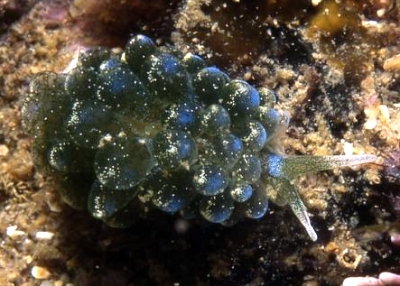
Dear Bill,
I have seen in the species description for Ercolania coerulea that this species is cited in the Western Mediterranean Sea, but there is no such picture in the Forum. I have submitted two pictures from my friend photographer Enric Madrenas, to illustrate the local variation of this slug.
Locality: Cala Aiguafreda, Begur, Costa Brava, 6-7 meters, Spain, Mediterranean Sea, 15 april 2005, Rocky bottom covered with algae. Length: 10 mm. aprox.. Photographer: Enric Madrenas.
Subjective picture analysis shows that maybe the Western Mediterranean species shows a darker color pattern than the specimens from other places of the world, I guess this is probably related to its feeding.
By looking at our pictures, I can understand better the etymology of the species name "coerulea" which refers to the blue stains on this species' cerata.
Best regards,
Miquel Pontes
miquelpontes@gmail.com
Pontes, M., 2007 (Sep 26) Ercolania coerulea from Spain. [Message in] Sea Slug Forum. Australian Museum, Sydney. Available from http://www.seaslugforum.net/find/20786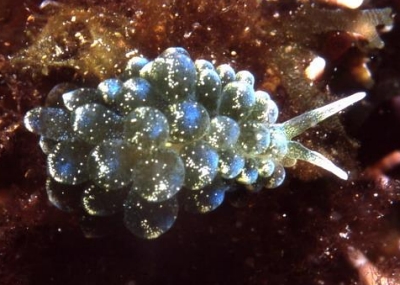
Thanks Miquel,
This is a useful addition to the Forum
Best wishes,
Bill Rudman
Ercolania coerulea from Slovenia
April 19, 2005
From: Tom Turk

Dear Bill,
This picture was photographed in 3 m depth in front of Marine biological station in Piran, Slovenia.
In my opinion the specimen is Ercolania coerulea, could you confirm the identification?
Locality: Piran, Marine biological station, Slovenia, northern Adriatic. Depth: 3 m. Length: 1.5 cm. March 26th 2005. rocky infralitoral with patches of sand and gravel. Photographer: Samo Alajbegovic
Tom Turk
tom.turk@bf.uni-lj.si
Turk, T., 2005 (Apr 19) Ercolania coerulea from Slovenia. [Message in] Sea Slug Forum. Australian Museum, Sydney. Available from http://www.seaslugforum.net/find/13536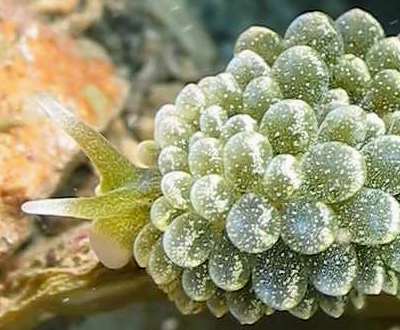
Dear Tom.
Yes this is Ercolania coerulea. The blue spots which are painted so prominently in the illustration in Schmekel & Portmann (1982) can be seen as a whitish patch on some of the cerata in your photo and are apparently reflected light which has been affected by the microscopic cilia covering the cerata, rather than spots caused by blue pigmentation. The photo shows the green branching digestive gland in the head, and the white tip and white lines down each side of the inflated cerata.
It's good to get a photo of typical Ercolania coerulea from the Mediterranean on the Forum
Best wishes,
Bill Rudman
Re: Ercolania coerulea from Hong Kong
April 12, 2005
From: Kathe R. Jensen
Dear Bill & Cynthia,
Concerning message #13385: Yes this is Ercolania coerulea. The species probably has a circumtropical distribution, so a record from Okinawa will be a further confirmation of this.
It is funny that you say your specimens from Dictyosphaeria were more bluish than those from Valonia. In Florida I found exactly the opposite. I guess pigments or precursors in the algae differ from species to species as well as locality to locality.
Best wishes,
Kathe
krjensen@zmuc.ku.dk
Jensen, K.R., 2005 (Apr 12) Re: Ercolania coerulea from Hong Kong. [Message in] Sea Slug Forum. Australian Museum, Sydney. Available from http://www.seaslugforum.net/find/13438Thanks Kathe,
Bill Rudman
Re: Ercolania sp.? from Hachijo Is, Japan
March 25, 2005
From: Kazuhiro Hiroe
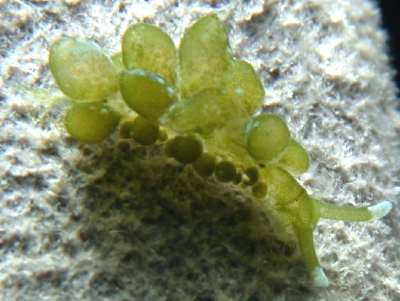
Dear Dr. Rudman and Dr. Jensen,
Thank you very much for your valuable opinions [messages #13411, #13413]. This attached photograph is a juvenile Stiliger smaragdinus (3mm long). I found it on green alga Caulerpa okamurae.
Best Regards,
Kazuhiro Hiroe
aquablue@cello.ocn.ne.jp
Hiroe, K., 2005 (Mar 25) Re: Ercolania sp.? from Hachijo Is, Japan. [Message in] Sea Slug Forum. Australian Museum, Sydney. Available from http://www.seaslugforum.net/find/13419
Dear Kazu,
Thanks for the photo of a juvenile Stiliger smaragdinus. It certainly suggests your earlier animal is Ercolania coerulea, as Kathe Jensen said in her comments, although I think I can see branched ducts of the digestive gland in the rhinophores in the close-up alongside. One obvious difference seems to be that in Stiliger smaragdinus the inner cerata are much larger than the outer ones, while in Ercolania coerulea they are all fairly uniform in size.
Best wishes,
Bill Rudman
Ercolania sp.? from Hachijo Is, Japan
March 24, 2005
From: Kazuhiro Hiroe
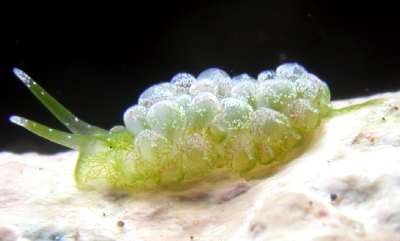
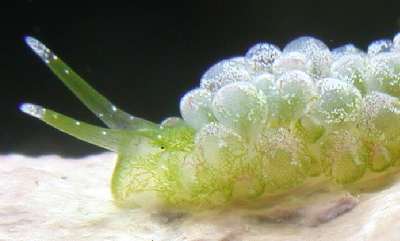
Dear Dr. Rudman,
This animal could be found on the green alga Boodlea coacta. I feel it maybe belong to Ercolania, but I'm not sure. Please give me your opinion on this species.
Locality: Yaene, Hachijo Island, Tokyo, Japan. Depth: 5 m. Length: 4 mm. 20 March 2005. Photographer: Kazuhiro Hiroe.
Best Regards,
Kazuhiro Hiroe
aquablue@cello.ocn.ne.jp
Hiroe, K., 2005 (Mar 24) Ercolania sp.? from Hachijo Is, Japan. [Message in] Sea Slug Forum. Australian Museum, Sydney. Available from http://www.seaslugforum.net/find/13411Dear Kazu,
I suspect this is a juvenile Stiliger smaragdinus, but it's difficult to be sure. Certainly the narrow foot extending behind the last cerata is typical of juveniles of this species, as are the rounded cerata and the white-tipped rhinophores. Your photo shows the cerata to be quite white at the tips, which is unusual for this species but I suspect they are a concentration of the glands which produce a whitish secretion in this species.
I may be quite wrong but I suspect it was just crawling over the green alga Boodlea, rather than feeding on it.
Best wishes,
Bill Rudman
Re: Ercolania sp.? from Hachijo Is, Japan
March 24, 2005
From: Kathe R. Jensen
Dear Bill & Kazu,
Concerning Kazu's mesage [#13411]: I think this is a juvenile Ercolania coerulea. In Florida I found juveniles of this species on Cladophoropsis, which I think is rather similar to Boodlea. The juvenile Stiliger smaragdinus that I have seen (in Rottnest Island) all had the typical solid rhinophores with white tips and also a distinct transverse white line across the head behind the eyes. Ercolania coerulea has the branching digestive gland tubules in rhinophores as well as the tail.
Best wishes,
Kathe
krjensen@zmuc.ku.dk
Jensen, K.R., 2005 (Mar 24) Re: Ercolania sp.? from Hachijo Is, Japan. [Message in] Sea Slug Forum. Australian Museum, Sydney. Available from http://www.seaslugforum.net/find/13413Thanks Kathe,
I am happy to agree. I should have said Ercolania coerulea, which we have had a number of messages about recently, was my second option.
Best wishes,
Bill Rudman
Re: Ercolania coerulea from Hong Kong
March 22, 2005
From: Cynthia Trowbridge

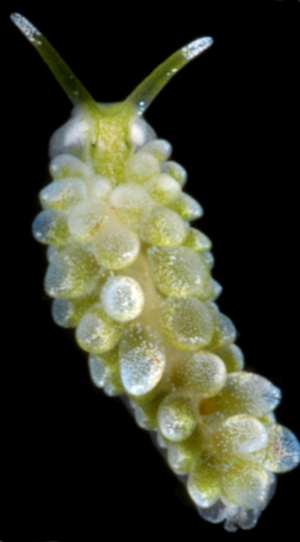
Dear Bill and Kathe,
I have just returned from another Okinawa trip with the Hiranos and students (from Chiba University). We found 7 Ercolania species on this 5-day trip including the one shown here.
This species was found on Valonia sp. and Dictyosphaeria cavernosa at several sites on the west coast of the main island of Okinawa (Okinawajima). Specimens from Dictyosphaeria are rather bluish; animals from Valonia are not.
Locality: west coast, Okinawajima, Japan, East China Sea. Length: several mm (data in Japan). 10-15 March 2005 . shallow subtidal. Photographer: Tomohiro Watanabe
Would you call this species Ercolania coerulea? The reasons I think this may be the species include:
-
Bright green from color of ingested chloroplasts
-
Transparent except for reno-pericardium which is conspicuously white
-
Prominent, elongate pericardium
-
Digestive gland has a thin branch with short side-branches in each ceras (see close-up)
-
Fine network of diverticula on dorsal surface of head
-
Long, simple rhinophores with diverticula almost to tip
-
Anterior foot corners are drawn out
We will dissect the radular teeth in the next few weeks (which Kathe suggested should be large and sabot-shaped). I was hoping for a tentative identification as it may be a new record for Japan (e.g., not in Nakano 2004, Ono 2004, on the Okinawa Slug Site, or in any of Baba's papers). If colleagues from Japan have verified or unverified records of this species, I would grateful for details. Thanks!
All the best,
Cynthia
trowbric@onid.orst.edu
Trowbridge, C.D., 2005 (Mar 22) Re: Ercolania coerulea from Hong Kong. [Message in] Sea Slug Forum. Australian Museum, Sydney. Available from http://www.seaslugforum.net/find/13385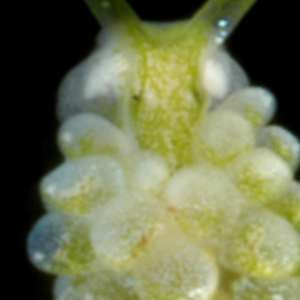
Dear Cynthia,
You seem to have had a productive time. I'll leave the comments to Kathe. I've added a close-up of the green animal alongside to show the fine branching of the digestive gland.
Best wishes,
Bill Rudman
Re: Ercolania coerulea from Tanzania
March 12, 2005
From: Bill Rudman
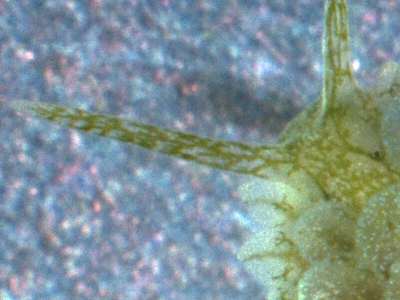
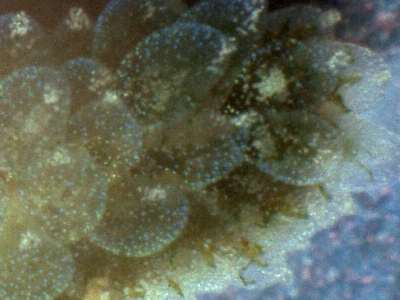
PHOTOS:Oyster Bay, Dar es Salaam, Tanzania. 25 Feb 1978 on algae Dictyosphaeria cavernosa. 8 animals, largest 12mm long alive. Photos: Bill Rudman
To accompany Kathe Jensen's photos of Ercolania coerulea from Hong Kong [message #13313 ], I have decided to add some close-ups of the photos I posted earlier [message #6580] of this species from Tanzania. In these you can see the branched green digestive gland ducts ramifying through the rhinophores and the head, and up into the cerata. In the lower photo, opaque white pigmentation covers the tip of each ceras and forms a short line down each edge of the ceras, as described by Schmekel & Portmann for Mediterranean specimens [see Fact Sheet], but there is no sign of the blue spots mentioned by them. The dull whitish spots all over the cerata are glands, rather than surface pigmentation, and do appear bluish in certain light.
Bill Rudman
Rudman, W.B., 2005 (Mar 12) Re: Ercolania coerulea from Tanzania. [Message in] Sea Slug Forum. Australian Museum, Sydney. Available from http://www.seaslugforum.net/find/13310Ercolania coerulea from Hong Kong
March 12, 2005
From: Kathe R. Jensen

Dear Bill,
I am submitting another scanned slide of a Hong Kong sacoglossan. This is Ercolania coerulea. The specimen was collected on Dictyosphaeria cavernosa at Bluff Head on April 23, 1989. I have no notes on the size of the animal, but my guess is that it was about 10 mm.
Ercolania coerulea feeds on Dictyosphaeria and lays its egg masses on this alga. The egg masses are often more visible, because the eggs are white, than the slugs, which are very well camouflaged and sometimes hiding on the underside of algal clumps.
Locality: Bluff Head, Hong Kong, South China Sea. Depth: shallow subtidal. Length: ca. 10 mm. 23 April 1989. rocky shore. Photographer: Kathe Jensen
Best wishes,
Kathe
krjensen@zmuc.ku.dk
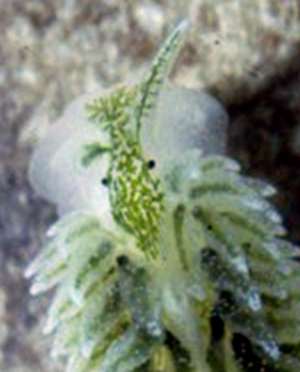
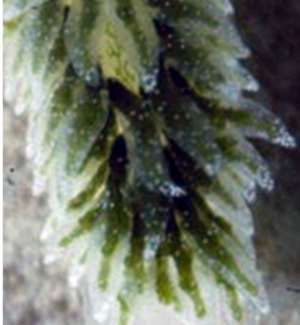
Dear Kathe,
This certainly looks quite like the animal I found in Tanzania [message #6580], also on Dictyosphaeria.
Best wishes,
Bill Rudman
Re: Ercolania cf. coerulea from Tanzania
April 3, 2002
From: Juan Lucas Cervera
Dear Kathe and Bill,
I agree with you that this animal from Tanzania fits within my concept of Ercolania coerulea. Obviously, the iridiscent blue shading is not in Bill's animal, but it is not stated how variable this feature is in Mediterranean specimens, even if the etymology of the species is linked to it.
Cheers.
Lucas.
lucas.cervera@uca.es
Cervera, J.L., 2002 (Apr 3) Re: Ercolania cf. coerulea from Tanzania. [Message in] Sea Slug Forum. Australian Museum, Sydney. Available from http://www.seaslugforum.net/find/6657Re: Ercolania cf. coerulea from Tanzania
March 31, 2002
From: Kathe R. Jensen
Dear Bill,
Yes, your animal from Tanzania fits my notion of Ercolania coerulea fairly well. The digestive gland tubules in the rhinophores are more conspicuous than most of what I have seen, and there is usually a central - often brownish - digestive gland tubule in the cerata in addition to the fine network of green, superficial tubules.
Somewhere I have a slide (20 years old or so, from Florida) very similar to your lower slide, where you have to know what you are looking for to distinguish the animal from the alga. I hope we can get Lucas to agree on the identity. Anatomically E. coerulea can be distinguished by its very large teeth (only 2 or 3 in upper limb), and the small, pointed penial stylet.
Greetings,
Kathe
jensen@ait.ac.th
Jensen, K.R., 2002 (Mar 31) Re: Ercolania cf. coerulea from Tanzania. [Message in] Sea Slug Forum. Australian Museum, Sydney. Available from http://www.seaslugforum.net/find/6643Thanks Kathe,
Bill Rudman
Ercolania cf. coerulea from Tanzania
March 30, 2002
From: Bill Rudman


Dear Kathe,
Following your comments on Ercolania cf. coerulea, I would be interested in hearing your views on this animal which I found a couple of times on Dictyosphaeria cavernosa in Tanzania.
In the lower photo you can see how well camouflaged it is on its algal food the white marks on the bubble-shaped cerata matching the light reflected off the bubble-shaped cells of the algae. In the photo you can see the branching of the gut in the head and rhinophores. The cerata were essentially transparent except for scattered white specks which I assume are glandular, and some green streaking where thin digestive gland ducts reached out to the ceratal wall. The tip of each ceras was constricted and nipple-like, and packed with opaque white glandular granules. I have no record of blue spots.
PHOTO: Oyster Bay, Dar es Salaam, Tanzania. 25 Feb 1978 on algae Dictyosphaeria cavernosa. 8 animals, largest 12mm long alive. Photos: Bill Rudman
I also found this species at the same locality on Dictyosphaeria in July 1975. Does this fit into your concept of Ercolania coerulescens or is that species restricted to the Mediterranean - Atlantic region?
Best wishes,
Bill Rudman
